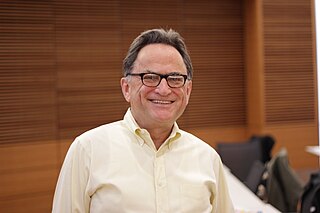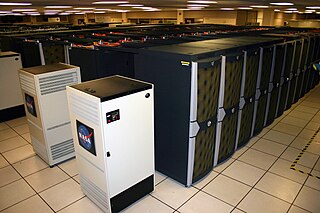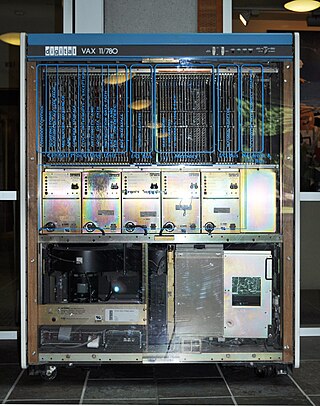Related Research Articles

A supercomputer is a computer with a high level of performance as compared to a general-purpose computer. The performance of a supercomputer is commonly measured in floating-point operations per second (FLOPS) instead of million instructions per second (MIPS). Since 2017, there have existed supercomputers which can perform over 1017 FLOPS (a hundred quadrillion FLOPS, 100 petaFLOPS or 100 PFLOPS). For comparison, a desktop computer has performance in the range of hundreds of gigaFLOPS (1011) to tens of teraFLOPS (1013). Since November 2017, all of the world's fastest 500 supercomputers run on Linux-based operating systems. Additional research is being conducted in the United States, the European Union, Taiwan, Japan, and China to build faster, more powerful and technologically superior exascale supercomputers.
Computerized batch processing is a method of running software programs called jobs in batches automatically. While users are required to submit the jobs, no other interaction by the user is required to process the batch. Batches may automatically be run at scheduled times as well as being run contingent on the availability of computer resources.
Grid computing is the use of widely distributed computer resources to reach a common goal. A computing grid can be thought of as a distributed system with non-interactive workloads that involve many files. Grid computing is distinguished from conventional high-performance computing systems such as cluster computing in that grid computers have each node set to perform a different task/application. Grid computers also tend to be more heterogeneous and geographically dispersed than cluster computers. Although a single grid can be dedicated to a particular application, commonly a grid is used for a variety of purposes. Grids are often constructed with general-purpose grid middleware software libraries. Grid sizes can be quite large.

High-performance computing (HPC) uses supercomputers and computer clusters to solve advanced computation problems.
HTCondor is an open-source high-throughput computing software framework for coarse-grained distributed parallelization of computationally intensive tasks. It can be used to manage workload on a dedicated cluster of computers, or to farm out work to idle desktop computers – so-called cycle scavenging. HTCondor runs on Linux, Unix, Mac OS X, FreeBSD, and Microsoft Windows operating systems. HTCondor can integrate both dedicated resources and non-dedicated desktop machines into one computing environment.
The HTC Corporation is a Taiwanese manufacturer of handheld devices.
UNICORE (UNiform Interface to COmputing REsources) is a grid computing technology for resources such as supercomputers or cluster systems and information stored in databases. UNICORE was developed in two projects funded by the German ministry for education and research (BMBF). In European-funded projects UNICORE evolved to a middleware system used at several supercomputer centers. UNICORE served as a basis in other research projects. The UNICORE technology is open source under BSD licence and available at SourceForge.

EPCC, formerly the Edinburgh Parallel Computing Centre, is a supercomputing centre based at the University of Edinburgh. Since its foundation in 1990, its stated mission has been to accelerate the effective exploitation of novel computing throughout industry, academia and commerce.

The Open Grid Forum (OGF) is a community of users, developers, and vendors for standardization of grid computing. It was formed in 2006 in a merger of the Global Grid Forum and the Enterprise Grid Alliance. The OGF models its process on the Internet Engineering Task Force (IETF), and produces documents with many acronyms such as OGSA, OGSI, and JSDL.

Miron Livny is a senior researcher and professor specializing in distributed computing at the University of Wisconsin–Madison. Livny has been a professor of computer science at Wisconsin since 1983, where he leads the HTCondor high-throughput computing system project. Miron is also a principal investigator and currently the facility coordinator for the Open Science Grid project, Director of the Center for High Throughput computing, CTO of Wisconsin Institutes for Discovery, and Director of Core Computational Technology of the Morgridge Institute for Research.
The Oak Ridge Leadership Computing Facility (OLCF), formerly the National Leadership Computing Facility, is a designated user facility operated by Oak Ridge National Laboratory and the Department of Energy. It contains several supercomputers, the largest of which is an HPE OLCF-5 named Frontier, which was ranked 1st on the TOP500 list of world's fastest supercomputers as of June 2022. It is located in Oak Ridge, Tennessee.

Univa was a software company that developed workload management and cloud management products for compute-intensive applications in the data center and across public, private, and hybrid clouds, before being acquired by Altair Engineering in September 2020.
In computing, performance per watt is a measure of the energy efficiency of a particular computer architecture or computer hardware. Literally, it measures the rate of computation that can be delivered by a computer for every watt of power consumed. This rate is typically measured by performance on the LINPACK benchmark when trying to compare between computing systems: an example using this is the Green500 list of supercomputers. Performance per watt has been suggested to be a more sustainable measure of computing than Moore’s Law.

A computer cluster is a set of computers that work together so that they can be viewed as a single system. Unlike grid computers, computer clusters have each node set to perform the same task, controlled and scheduled by software.
Many-task computing (MTC) in computational science is an approach to parallel computing that aims to bridge the gap between two computing paradigms: high-throughput computing (HTC) and high-performance computing (HPC).
Techila Distributed Computing Engine is a commercial grid computing software product. It speeds up simulation, analysis and other computational applications by enabling scalability across the IT resources in user's on-premises data center and in the user's own cloud account. Techila Distributed Computing Engine is developed and licensed by Techila Technologies Ltd, a privately held company headquartered in Tampere, Finland. The product is also available as an on-demand solution in Google Cloud Launcher, the online marketplace created and operated by Google. According to IDC, the solution enables organizations to create HPC infrastructure without the major capital investments and operating expenses required by new HPC hardware.

Quasi-opportunistic supercomputing is a computational paradigm for supercomputing on a large number of geographically disperse computers. Quasi-opportunistic supercomputing aims to provide a higher quality of service than opportunistic resource sharing.

The history of computer clusters is best captured by a footnote in Greg Pfister's In Search of Clusters: “Virtually every press release from DEC mentioning clusters says ‘DEC, who invented clusters...’. IBM did not invent them either. Customers invented clusters, as soon as they could not fit all their work on one computer, or needed a backup. The date of the first is unknown, but it would be surprising if it was not in the 1960s, or even late 1950s.”
Cycle Computing is a company that provides software for orchestrating computing and storage resources in cloud environments. The flagship product is CycleCloud, which supports Amazon Web Services, Google Compute Engine, Microsoft Azure, and internal infrastructure. The CycleCloud orchestration suite manages the provisioning of cloud infrastructure, orchestration of workflow execution and job queue management, automated and efficient data placement, full process monitoring and logging, within a secure process flow.
Computation offloading is the transfer of resource intensive computational tasks to a separate processor, such as a hardware accelerator, or an external platform, such as a cluster, grid, or a cloud. Offloading to a coprocessor can be used to accelerate applications including: image rendering and mathematical calculations. Offloading computing to an external platform over a network can provide computing power and overcome hardware limitations of a device, such as limited computational power, storage, and energy.
References
- ↑ Beck, Alan (1997-06-27). "High Throughput Computing: An Interview with Miron Livny (Broken link)". HPCWire.
- ↑ "High Throughput Computing: An Interview with Miron Livny (Backup link)".
- ↑ "EGI Glossary V1".